| Eunotiales | |
|---|---|
 | |
| Eunotia sp. | |
| Scientific classification | |
| Clade: | SAR |
| Phylum: | Ochrophyta |
| Class: | Bacillariophyceae |
| Order: | Eunotiales P. C. Silva, 1962 [1] |
| Families | |
Eunotiales is an order of diatoms, which belongs to Subclass EunotiophycidaeD.G.Mann.
| Eunotiales | |
|---|---|
 | |
| Eunotia sp. | |
| Scientific classification | |
| Clade: | SAR |
| Phylum: | Ochrophyta |
| Class: | Bacillariophyceae |
| Order: | Eunotiales P. C. Silva, 1962 [1] |
| Families | |
Eunotiales is an order of diatoms, which belongs to Subclass EunotiophycidaeD.G.Mann.

Algae is an informal term for a large and diverse group of photosynthetic eukaryotic organisms. It is a polyphyletic grouping that includes species from multiple distinct clades. Included organisms range from unicellular microalgae, such as Chlorella,Prototheca and the diatoms, to multicellular forms, such as the giant kelp, a large brown alga which may grow up to 50 metres (160 ft) in length. Most are aquatic and autotrophic and lack many of the distinct cell and tissue types, such as stomata, xylem and phloem that are found in land plants. The largest and most complex marine algae are called seaweeds, while the most complex freshwater forms are the Charophyta, a division of green algae which includes, for example, Spirogyra and stoneworts.

Chlorophyta or Prasinophyta is a taxon of green algae informally called chlorophytes. The name is used in two very different senses, so care is needed to determine the use by a particular author. In older classification systems, it refers to a highly paraphyletic group of all the green algae within the green plants (Viridiplantae) and thus includes about 7,000 species of mostly aquatic photosynthetic eukaryotic organisms. In newer classifications, it refers to the sister clade of the streptophytes/charophytes. The clade Streptophyta consists of the Charophyta in which the Embryophyta emerged. In this latter sense the Chlorophyta includes only about 4,300 species. About 90% of all known species live in freshwater. Like the land plants, green algae contain chlorophyll a and chlorophyll b and store food as starch in their plastids.

A flagellate is a cell or organism with one or more whip-like appendages called flagella. The word flagellate also describes a particular construction characteristic of many prokaryotes and eukaryotes and their means of motion. The term presently does not imply any specific relationship or classification of the organisms that possess flagella. However, the term "flagellate" is included in other terms which are more formally characterized.

An algal bloom or algae bloom is a rapid increase or accumulation in the population of algae in freshwater or marine water systems. It is often recognized by the discoloration in the water from the algae's pigments. The term algae encompasses many types of aquatic photosynthetic organisms, both macroscopic multicellular organisms like seaweed and microscopic unicellular organisms like cyanobacteria. Algal bloom commonly refers to the rapid growth of microscopic unicellular algae, not macroscopic algae. An example of a macroscopic algal bloom is a kelp forest.

Phycology is the scientific study of algae. Also known as algology, phycology is a branch of life science.

Brown algae, comprising the class Phaeophyceae, are a large group of multicellular algae, including many seaweeds located in colder waters within the Northern Hemisphere. Brown algae are the major seaweeds of the temperate and polar regions. They are dominant on rocky shores throughout cooler areas of the world. Most brown algae live in marine environments, where they play an important role both as food and as a potential habitat. For instance, Macrocystis, a kelp of the order Laminariales, may reach 60 m (200 ft) in length and forms prominent underwater kelp forests. Kelp forests like these contain a high level of biodiversity. Another example is Sargassum, which creates unique floating mats of seaweed in the tropical waters of the Sargasso Sea that serve as the habitats for many species. Many brown algae, such as members of the order Fucales, commonly grow along rocky seashores. Some members of the class, such as kelps, are used by humans as food.
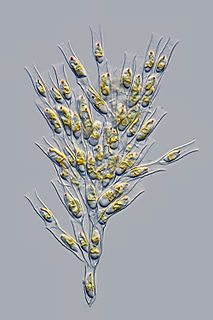
The Chrysophyceae, usually called chrysophytes, chrysomonads, golden-brown algae or golden algae are a large group of algae, found mostly in freshwater. Golden algae is also commonly used to refer to a single species, Prymnesium parvum, which causes fish kills.

The Embryophyta, or land plants, are the most familiar group of green plants that comprise vegetation on Earth. Embryophytes have a common ancestor with green algae, having emerged within the Phragmoplastophyta clade of green algae as sister of the Zygnematophyceae/Mesotaeniaceae. The Embryophyta consist of the bryophytes plus the polysporangiophytes. Living embryophytes therefore include hornworts, liverworts, mosses, lycophytes, ferns, gymnosperms and flowering plants. The land plants have diplobiontic life cycles and is shown that the Charophycean green algae gave rise to land plants.

In biology, a biological life cycle is a series of changes in form that an organism undergoes, returning to the starting state. "The concept is closely related to those of the life history, development and ontogeny, but differs from them in stressing renewal." Transitions of form may involve growth, asexual reproduction, or sexual reproduction.
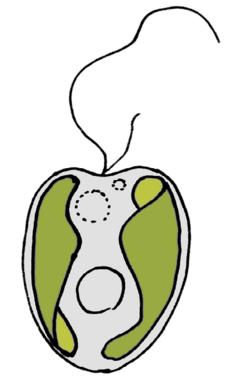
Heterokonts are a group of protists. The group is a major line of eukaryotes. Most are algae, ranging from the giant multicellular kelp to the unicellular diatoms, which are a primary component of plankton. Other notable members of the Stramenopiles include the (generally) parasitic oomycetes, including Phytophthora, which caused the Great Famine of Ireland, and Pythium, which causes seed rot and damping off.

The Hydroscaphidae are a small family of water beetles known commonly as skiff beetles. As of 2010, there are 23 species in the family. Several are recently described.

Coralline algae are red algae in the order Corallinales. They are characterized by a thallus that is hard because of calcareous deposits contained within the cell walls. The colors of these algae are most typically pink, or some other shade of red, but some species can be purple, yellow, blue, white, or gray-green. Coralline algae play an important role in the ecology of coral reefs. Sea urchins, parrot fish, and limpets and chitons feed on coralline algae. In the temperate Mediterranean Sea, coralline algae are the main builders of a typical algal reef, the Coralligène ("coralligenous"). Many are typically encrusting and rock-like, found in marine waters all over the world. Only one species lives in freshwater. Unattached specimens may form relatively smooth compact balls to warty or fruticose thalli.

Viridiplantae are a clade of eukaryotic organisms that comprise approximately 450,000–500,000 species and play important roles in both terrestrial and aquatic ecosystems. They are made up of the green algae, which are primarily aquatic, and the land plants (embryophytes), which emerged from within them. Green algae traditionally excludes the land plants, rendering them a paraphyletic group. However it is accurate to think of land plants as a kind of algae. Since the realization that the embryophytes emerged from within the green algae, some authors are starting to include them. They have cells with cellulose in their cell walls, and primary chloroplasts derived from endosymbiosis with cyanobacteria that contain chlorophylls a and b and lack phycobilins.

The Archaeplastida are a major group of eukaryotes, comprising the photoautotrophic red algae (Rhodophyta), green algae, land plants, and the minor group glaucophytes. It also includes the non-photosynthetic lineage Rhodelphidia, a predatorial (eukaryotrophic) flagellate that is sister to the Rhodophyta, and probably the microscopic picozoans. The Archaeplastida have chloroplasts that are surrounded by two membranes, suggesting that they were acquired directly through a single endosymbiosis event by feeding on a cyanobacterium. All other groups which have chloroplasts, besides the amoeboid genus Paulinella, have chloroplasts surrounded by three or four membranes, suggesting they were acquired secondarily from red or green algae. Unlike red and green algae, glaucophytes have never been involved in secondary endosymbiosis events.

AlgaeBase is a global species database of information on all groups of algae, both marine and freshwater, as well as sea-grass.

Algae fuel, algal biofuel, or algal oil is an alternative to liquid fossil fuels that uses algae as its source of energy-rich oils. Also, algae fuels are an alternative to commonly known biofuel sources, such as corn and sugarcane. When made from seaweed (macroalgae) it can be known as seaweed fuel or seaweed oil.

Seaweed, or macroalgae, refers to thousands of species of macroscopic, multicellular, marine algae. The term includes some types of Rhodophyta (red), Phaeophyta (brown) and Chlorophyta (green) macroalgae. Seaweed species such as kelps provide essential nursery habitat for fisheries and other marine species and thus protect food sources; other species, such as planktonic algae, play a vital role in capturing carbon, producing at least 50% of Earth's oxygen.
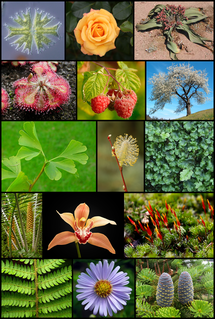
Plants are predominantly photosynthetic eukaryotes of the kingdom Plantae. Historically, the plant kingdom encompassed all living things that were not animals, and included algae and fungi; however, all current definitions of Plantae exclude the fungi and some algae, as well as the prokaryotes. By one definition, plants form the clade Viridiplantae which is sister of the Glaucophyta, and consists of the green algae and Embryophyta. The latter includes the flowering plants, conifers and other gymnosperms, ferns and their allies, hornworts, liverworts, and mosses.
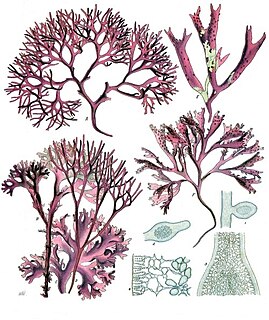
Red algae, or Rhodophyta, are one of the oldest groups of eukaryotic algae. The Rhodophyta also comprises one of the largest phyla of algae, containing over 7,000 currently recognized species with taxonomic revisions ongoing. The majority of species (6,793) are found in the Florideophyceae (class), and mostly consist of multicellular, marine algae, including many notable seaweeds. Red algae are abundant in marine habitats but relatively rare in freshwaters. Approximately 5% of red algae species occur in freshwater, environments with greater concentrations found in warmer areas. Except for two coastal cave dwelling species in the asexual class Cyanidiophyceae, there are no terrestrial species, which may be due to an evolutionary bottleneck in which the last common ancestor lost about 25% of its core genes and much of its evolutionary plasticity.
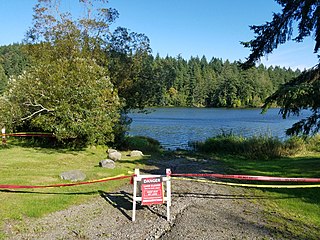
Anderson Lake State Park is a public recreation area on the Quimper Peninsula in Jefferson County, Washington. The state park has 496 acres (201 ha) of woods and wetland that slope down to 70-acre (28 ha) Anderson Lake. The park offers picnicking, trails for hiking, biking, and equestrian use, non-motorized boating, fishing, and birdwatching. The presence of toxic algae forbids water use of any kind from time to time.